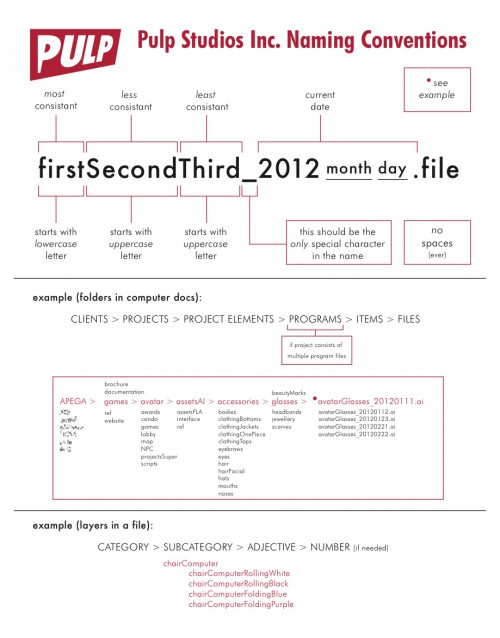Organization in the work place…
Hey folks,
This blog post is all about my perspective on organization in the work place.
My perspective is that organization is vital.
That is all.
Oh, you wanted more? Ok, so I can’t really get away with a few sentences. Let me chat some more. First off, I understand that organization is hard for a lot of creative people. The whole left brain versus right brain thinking isn’t something we can avoid. I’ll admit I’m an odd case in my field. When it comes to being an A-type personality in a creative studio, I feel out of place at times. We joke that I’m the “robot” at the office because of my detail-oriented ways of life. So for those of you who aren’t fellow robots, I hope this blog post will give you a helpful peek into our hard drives. I mean brains.
Organization can help not only you but everyone you interact with, like co-workers, clients, and contractors. Communication is also a huge asset in companies and I think these two elements go hand-in-hand. Being organized helps make a clear path to information for you or someone else (communication). Let’s say you’re not in the office one day and someone needs a pink and green marker from your desk. It’s a lot easier to find those markers if they are all together in one specific place and in an area that makes sense. If they’re hiding behind some books or a computer monitor then they might not be easy to hunt down. Another example would be if someone needs to get a specific file from your computer but they don’t know the name of the file. Maybe you need to find an old file that you haven’t used in a while. Maybe you’ve set up some characters for an animation and the animator needs a clean file to work from instead of them taking extra time to clean it up. There are numerous scenarios and examples that could be given as to why organization is an essential key in our daily lives. It’s true when they say that taking ten minutes now could save you a few hours in the future. Trust me, it’s not an exaggeration. *Quivers*
I have a few tips for helping with organization. One of them is to have standard conventions. Name all of your files the same way. Put the markers in a basket. Put the lunches in the fridge. Sticking to a plan is important in the upkeep of organization. Another tip is to recognize hierarchy and priority. This will help you when making standard conventions.
For example, in my Finder on my Mac at work you’ll find folders. Lots and lots of pretty little folders. In the main “Pulp Projects” folder there are folders with client names. In the client folders there are folders for each project we’ve worked on with them. Inside the project folder there are folders for different types of files (ex: ai, fla, pdf, psd, mov…). Finally, in the file folders there are the working files. The files are named specifically to describe itself and dated. Computers are smart and display files and folders in chronological and numerical order. Dating files will automatically put them in order from the beginning to end of a project because they are in numerical order. A lovely system, isn’t it?
Next… hierarchy! Step back and ask yourself, “What’s the most consistent item and the least consistent item?” and, “What goes in between?” Make a quick list. It’s nice to jot down some notes before diving into things. In my case the most consistent to the least consistent items in my “Pulp Projects” folder were clients, projects, then files. Now that I may or may not have confused the heck out of you, I’ll give you a visual example…
Better? If so, super duper! If not, that’s ok! Not everyone uses the same conventions for organizing themselves. I just learned this method when I was attending Guru Digital Arts College and loved it so much that I couldn’t get it out of my system. If it’s not broken, don’t fix it, I guess. Take a peek at other ways of going about it or make up your own.
As an animator, I stick by these rules for every project. It’s especially helpful when there are lots of animations, files for those animations, and assets within those files. Here’s my secret recipe to standard naming conventions (and more specific examples)…
My last example is how to take those naming conventions and apply them to assets within files…
Well, I hope this has been somewhat insightful. Thanks so much for reading!
Meaghen

















1 Comment
Karl Chvojka
December 3, 2012And Yoink! Thanks Meaghen. Now I need to revamp all my file structures. Something I’ve been considering for some time now, but haven’t gotten around to it 🙂